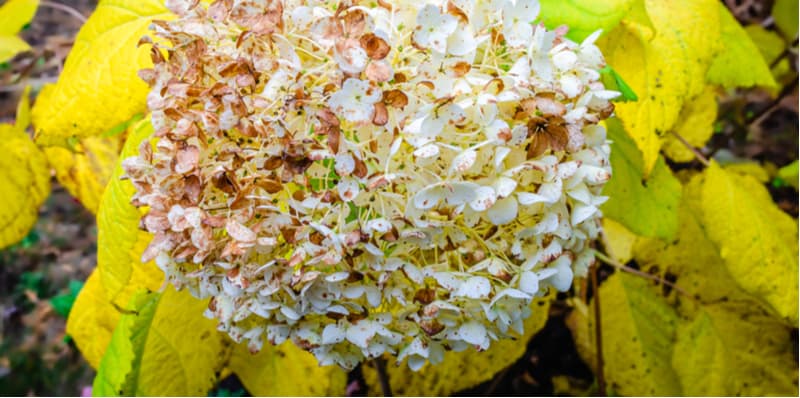The Ultimate Guide To Hydrangea Leaves Turning Yellow
Table of ContentsWhat Does Hydrangea Leaves Turning Yellow Do?10 Simple Techniques For Hydrangea Leaves Turning YellowWhat Does Hydrangea Leaves Turning Yellow Mean?Not known Incorrect Statements About Hydrangea Leaves Turning Yellow The Ultimate Guide To Hydrangea Leaves Turning Yellow7 Easy Facts About Hydrangea Leaves Turning Yellow Explained
One possibility is that the plant is not obtaining adequate sunshine. Throughout the winter season months, the days are shorter, and the sun is not as intense, so make sure to place your Hydrangea in an area where it will certainly access least 6 hours of sunshine daily. An additional factor for Hydrangea yellow fallen leaves in winter can be excessive water.The leaves might be transforming yellow due to temperature level stress. Hydrangeas like cooler temperature levels, so if the plant remains in an area that gets too hot or too chilly, the leaves will certainly transform yellow. If you believe temperature level anxiety could be the problem, try relocating your Hydrangea to a different area or securing it from the components with a cloth wrap.
New development will certainly be observed in early spring, when you'll see environment-friendly foliage sprouting from stems that could have shown up dead. Nonetheless, if your fallen leaves are turning brown in spring or summer season, there are likely other aspects at play. The specific factors rely on the selection and their growing conditions, but in basic, brown hydrangea leaves suggest dehydration and wilting in the warmth
Getting The Hydrangea Leaves Turning Yellow To Work

Wilting is triggered by lack of moisture, implying there are a couple of good methods to use to avoid this from taking place. Give your hydrangeas a healthy glug of water every couple of days when the temperature levels are climbing up high, and treat the dirt to better preserve moisture. After watering, a dab of mulch around the base of each plant need to assist with this by maintaining wetness in the dirt.
This interferes with fungi spores from clearing up. "The Botrytis fungi grows in trendy and damp conditions, so stay clear of bathing the entire plant when watering and just water at the roots," shares Roy Nicol, a Master Gardener. If you have actually missed the opportunity for prevention and are taking care of an infection you should eliminate all dead or severely contaminated leaves from the plant and destroy them to avoid additional spread.
All About Hydrangea Leaves Turning Yellow
As a basic general rule, we advise eliminating leaves when they are 50% brownish or greater. While browning triggered by any reason can't be turned around, taking the restorative action explained above will certainly motivate the plant to expand new leaves so the harmed fallen leaves either diminish normally or can be eliminated by the garden enthusiast.
Hydrangeas need to be watered only when the top few inches of soil are dry, and must be provided an extensive saturating each time. Underwatered hydrangeas are most likely to have yellow, wilting, and drooping leaves. Increase the regularity and amount of watering for your hedge to assist address this concern. Hydrangeas choose fairly damp (however not soaked) soil, so offer the origins a good saturating and enable water to be soaked up into the soil before applying more.
The means you repair hydrangea leaves turning yellow depends upon the vital problem triggering the yellow leaves. This can be difficult to figure out, once you do you will be able to readjust your plant treatment as necessary to deal with the trouble. More Info As pointed out before, a common issue with hydrangeas is vitamins and mineral shortages.
The Of Hydrangea Leaves Turning Yellow
Throughout the height expanding season, you should sprinkle at a price of regarding 1 inch each week. If you are stressed over not appropriately watering your hydrangeas, there are a pair of things you can do. Adding mulch to the base of the plants over the root area help to regulate the temperature around the shrub he said and keep water in the dirt.
Additionally, you can purchase and set up simple watering globes. Sprinkling worlds hold water in them and slowly launch this water into the dirt as the ground becomes completely dry. Just fill up the globe with water, stick the spout right into the soil within the root area near the base of the plant, and leave it in position until all the water is gone.
If it is too severe, some plants will never ever recoup from transplant shock and will certainly continue to decline till they pass away. Minimize transplant shock by consisting of as several roots as possible when excavating up your plant to relocate. Make sure to give more water than normal in the weeks following growing to aid your plant recover and expand brand-new origins.
Hydrangea Leaves Turning Yellow Can Be Fun For Everyone
To prevent spreading out fungal diseases, be sure to thouroughly clean and decontaminate any type of pruning tools prior to and after use. Finally, you can attempt to purge the roots with water to eliminate excess fertlizer.
Your hydrangea plant chooses well-drained, moist dirt. If the pot has bad drain, or your soil is swamped, the fallen leaves will begin to transform yellow.
If you do not water your hydrangea plant for more than a week, the fallen leaves will begin transforming yellow. Fungal conditions that attack the plants tend Get More Info to reveal join the roots and the leaves of the plant. One of these diseases is root rot, that makes it challenging for the plant to feed correctly.
The Definitive Guide to Hydrangea Leaves Turning Yellow
